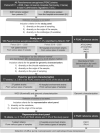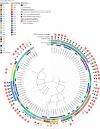A 10-year microbiological study of Pseudomonas aeruginosa strains revealed the circulation of populations resistant to both carbapenems and quaternary ammonium compounds
- PMID: 36788252
- PMCID: PMC9929048
- DOI: 10.1038/s41598-023-29590-0
A 10-year microbiological study of Pseudomonas aeruginosa strains revealed the circulation of populations resistant to both carbapenems and quaternary ammonium compounds
Abstract
Pseudomonas aeruginosa is one of the leading causes of healthcare-associated infections. For this study, the susceptibility profiles to antipseudomonal antibiotics and a quaternary ammonium compound, didecyldimethylammonium chloride (DDAC), widely used as a disinfectant, were established for 180 selected human and environmental hospital strains isolated between 2011 and 2020. Furthermore, a genomic study determined resistome and clonal putative relatedness for 77 of them. During the ten-year study period, it was estimated that 9.5% of patients' strains were resistant to carbapenems, 11.9% were multidrug-resistant (MDR), and 0.7% were extensively drug-resistant (XDR). Decreased susceptibility (DS) to DDAC was observed for 28.0% of strains, a phenotype significantly associated with MDR/XDR profiles and from hospital environmental samples (p < 0.0001). According to genomic analyses, the P. aeruginosa population unsusceptible to carbapenems and/or to DDAC was diverse but mainly belonged to top ten high-risk clones described worldwide by del Barrio-Tofiño et al. The carbapenem resistance appeared mainly due to the production of the VIM-2 carbapenemase (39.3%) and DS to DDAC mediated by MexAB-OprM pump efflux overexpression. This study highlights the diversity of MDR/XDR populations of P. aeruginosa which are unsusceptible to compounds that are widely used in medicine and hospital disinfection and are probably distributed in hospitals worldwide.
© 2023. The Author(s).
Conflict of interest statement
The authors declare no competing interests.
Figures






References
-
- European Centre for Disease Prevention and Control & World Health Organization. Antimicrobial Resistance Surveillance in Europe 2022 to 2020 Data. 164. 10.2900/112339 (2022).
Publication types
MeSH terms
Substances
Associated data
LinkOut - more resources
Full Text Sources
Miscellaneous

